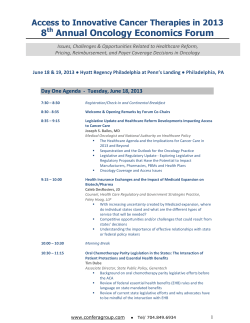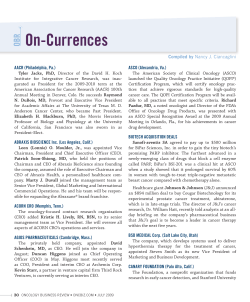
1. Management of Oncology Patients with Neutropenia 1.1 Purpose
Canterbury District Health Board Name of Division Name of Manual Policy 1. Management of Oncology Patients with Neutropenia 1.1 Purpose This document provides guidance on how Oncology Service patients presenting to acute services with neutropenia or neutropenic sepsis are managed by medical and nursing staff. 1.2 Scope Medical and nursing staff within the Canterbury District Health Board assessing and treating Oncology Service patients with neutropenia or neutropenic sepsis. 1.3 Associated Documents Oncology Service Medical Management Guidelines Immunosuppressed Patients Clinical Pathway (C240085) Oncology Outpatient Department Triage Assessment Form CDHB Infection Control Manual Volume 10 CDHB Fluid and Medication Management Manual Volume 12 After Hours Phone Call form Patient Neutropenia Card CDHB Management Guidelines for Common Medical Conditions (Blue book) CDHB Preferred Medicines List (Pink Book) 1.4 Definitions A normal neutrophil level is between 2-8x10E9/L Clinical management is escalated when neutrophils are 1.0 or below Neutropenia - An abnormal decrease in the number of neutrophils in the blood. Neutropenia is associated with a profound impairment in the inflammatory response, leading to a lack or minimisation of the usual signs and symptoms of infection. Neutropenia is a common problem in oncology patients either following chemotherapy, or less commonly secondary to radiation treatment or marrow infiltration by malignancy. Neutropenia is most likely to occur 10-14 days post-chemotherapy Febrile Neutropenia - occurs when a patient has a fever and a significant reduction in their neutrophils. The fever may be caused by an infectious agent, and when it is, rapid treatment is required. A patient with febrile neutropenia needs assessment for the possible source and type of infection and treatment until the cause is found or it subsides. The risk of infection increases directly in proportion to the degree of neutropenia and its duration. Neutropenic sepsis and septic shock - Neutropenic sepsis and septic shock are life-threatening and should be dealt with urgently. Sepsis describes clinical syndromes resulting from systemic inflammatory response. Diagnosis of sepsis is based on simple clinical criteria. The term septic shock represents an increased degree of the severity of sepsis where altered organ function or compromise occurs (e.g. hypotension, hypoxemia, lactic acidosis, oliguria, altered mental state). Septic shock carries high risk of mortality. 1.5 General Statements Initial Presentation to ED or Oncology Outpatients On initial presentation to Emergency Department or Oncology Outpatient Department the Immunosuppressed Patients Clinical Pathway (Oncology, Haematology & Transplant Patients) C240085 is commenced immediately (appendix A). Initial telephone call to Ward 27 afterhours See policy in Oncology Service Nursing Policy and Procedure Manual. Medical This document should be utilised in conjunction with the medical management guidelines for the Authorised By: Compiled By: http://interweb-d/cytotoxic/policies/Oncology Neutropenia Policy .doc Issue Date: Issue Number: 0.1 Draft Canterbury District Health Board Name of Division Name of Manual Policy Management Guidance Oncology Service. Acute Management • Record baseline observations o Abnormal parameters requiring medical review are: Temperature > 38oC or < 36oC Pulse > 120 bpm Respirations >20/min Blood pressure systolic < 100 O2 saturations <90% EWS 1+ o History and Examination • Continue observations (as per Immunosuppressed Patients Clinical Pathway) or as clinically indicated • Establish IV access (as per Immunosuppressed Patients Clinical Pathway) (22 gauge or larger) • Must document – abdominal pain, postural dizziness, COPD, dyspnoea, diarrhoea, beta blocker use Assess for clinical signs of infection o Sore throat o Mouth ulcers o Cough/sputum o Rigours o Dysuria o Urethral or vaginal discharge o Diarrhoea o Abdominal tenderness o Infected wound sites o Any indwelling devices e.g. CVAD’s, nephrostomies, PEG, IDC’s etc. • o Tests and Investigations hydration status • Baseline bloods (marked urgent) o CBC + Diff o DIAL (ED only) or ONCO • MC+S o o o o o Initial Management Intravenous fluids If unwell but not meeting above criteria requires medical review. Blood cultures – peripheral and CVAD (as indicated, one set per lumen) Sputum MSU Stool (include C Diff) Other swabs as clinically indicated i.e. mouth, throat, wound, devices etc. • CXR – urgent if clinically indicated or may be deferred until working hours if non urgent. CXR is not required unless there are symptoms (cough, dyspnea) or signs (tachypnoea, crackles, altered breath sounds, dullness, oxygen desaturation) to indicate respiratory illness • Tests and investigations should be complete within 30 minutes of arrival if unwell • • • • • Commence 0.9S 1000ml stat Fluid resuscitate as clinically indicated if sepsis or shock evident Patients who are shocked may require large amounts of IV fluid during resuscitation Use crystalloid preferentially Give 0.9S 1000ml boluses until BP normalising or JVP rising Authorised By: Compiled By: http://interweb-d/cytotoxic/policies/Oncology Neutropenia Policy .doc Issue Date: Issue Number: 0.1 Draft Canterbury District Health Board Name of Division Name of Manual Policy Acute pulmonary oedema may occur in unwell patients or those with underlying cardiac disease but this can be treated if necessary and should not be a barrier to adequate fluid resuscitation • Check observations as above every 15 minutes for the first hour (if initial measurement deranged or patient appears clinically unwell) • Stable patient - IVF’s as clinically indicated by blood pressure and urine output and medical assessment • First line antibiotics o Tazocin 4.5gm Q8H IV o If Tazocin unsuitable – Imipenem 500mg Q6H IV If nausea/vomiting from Imipenem consider Meropenem • Commence antibiotics prior to blood results if patient obviously unwell or wait for blood results if not obviously unwell (medical decision). • Antibiotics should be administered within 30 minutes of arrival/assessment if unwell. • For further antibiotic management refer to the Blue Book, http://intraweb.cdhb.local/manuals/handbooks/BlueBook/index.htm Not Neutropenic on return of bloods • If not neutropenic then manage according to likely clinical diagnosis Follow on Management High Risk Neutropenic Fever • Initial Management Antibiotics If neutropenic and any of the following high risk factors exist Unwell Abdominal pain or diarrhea Systolic BP <80% baseline or <100 or pulse >120 or EWS >2 COPD Confusion Dehydration Thrombocytopenic = manage as high risk neutropenic fever • Medical staff should contact ward medical oncologist or on call medical oncologist • If no risk criteria met then manage as low risk neutropenic fever High Risk Management • Transfer patient to ward once stable, nurse escort required for very unwell or unstable patients • Q15min T, P ,BP and RR until stable then hourly • Aggressive IV rehydration until normotensive • Strict fluid balance • Monitor urine output, MSU at first void • Commence stool chart for those with diarrhoea • CXR is not required unless indicated, see Tests and Investigations section • Consider additional antibiotics (aminoglycoside, metronidazole, vancomycin amphotericin) depending on clinical status and duration of neutropenia. • Consider starting G-CSF When stable for 12 hours, reduce frequency of recordings to four hourly and if stable after 12 hours move to low risk management Complicated High The following situations require additional management steps to be implemented Risk Authorised By: Issue Date: Compiled By: Issue Number: 0.1 Draft http://interweb-d/cytotoxic/policies/Oncology Neutropenia Policy .doc Canterbury District Health Board Name of Division • Hypoxemia or respiratory symptoms or signs on respiratory examination o o o o o • Arrange CXR once stable Give supplemental O2 to maintain SaO2 >90% Add clarithromycin 500mg q8h Consider pulmonary embolism or Pneumocystis jervecii pneumonia in the differential diagnosis Start G-CSF, consider respiratory service consultation Abdominal pain or diarrhea o o o o Follow on Management Low Risk Neutropenic Fever Name of Manual Policy Manage diarrhea aggressively (see Guideline – Management of Diarrhoea related to chemotherapy) Consider neutropenic enterocolitis Consider CT abdomen Start G-CSF • CVAD or severe soft tissue infection o Add vancomycin (see Pink Book for dosing guidelines) o Consider CVAD removal • Positive blood cultures o Check sensitivities and consider change to appropriate antibiotic monotherapy o Consider ID service consultation o Standard duration of IV antibiotics Low risk neutropenic fever • • • • On arrival to ED between 0800-1600 hours the Medical Oncology Ward Registrar is contacted for assessment or review. On arrival to Oncology Outpatient Department the Oncology Triage Registrar is contacted for assessment or review From 1600-2300 hours weekdays and 0800-2300 hours on weekends the on-call Oncology registrar is contacted. If unavailable the Oncologist on-call should be contacted (via switch). When admitted and while an inpatient the medical oncology ward registrar is contacted for assessment or review (0800-1600 hours). Low Risk Management • Encourage oral intake • Once on ward IVF may be discontinued • Send MSU at first void • CXR not required • Monitor T., P., BP Q4H for 12 hours o If stable at 12 hours, change to oral ciprofloxacin 500 mg BD and observe for a further 12 hours, continue Q4H obs. If well then discuss with consultant1 and discharge to community on oral antibiotics provided there are appropriate supports • if unstable or unwell or meets high risk criteria at any time then increase intensity of management to high risk neutropenic fever Inpatient Admission • • 1 If the patient requires admission this is to occur within an hour of assessment in ED and as negotiated with Oncology Outpatient Department. This is facilitated by contacting the Duty Manager for a bed and when confirmed by the Duty Decisions regarding early discharge of patients with neutropenic fever must be made by oncologist or senior registrar Authorised By: Issue Date: Compiled By: Issue Number: 0.1 Draft http://interweb-d/cytotoxic/policies/Oncology Neutropenia Policy .doc Canterbury District Health Board Name of Division • Transit of Neutropenic Patients Protective Isolation • • Manager a verbal handover both medical and nursing is to occur prior to transfer of the patient. All initial tests, investigations and documentation should be as complete as possible Patients requiring transport from one department to another department should wear a disposable mask while in transit. Transport should be limited to essential need only • If a patient is very unwell with sepsis or shock they should be escorted by a registered nurse or doctor • Patients should be placed into a single room if neutrophils are ≤ 0.5 x10E9/L and/or they demonstrate signs of infection If patients are “well” with no obvious signs of infection and the neutrophils are > 0.5 x10E9/L they may be nursed in a multi-bed room if no single room is available, as long as no other patients in that room are infectious A protective isolation sign should be displayed at the door (or above the patient bed in multibed room) Staff caring for the patient should be infection free Any staff must clean their hands with alcohol hand rub or use antimicrobial soap (containing chlorhexidine) and water prior to any activity with the patient A mask is not necessary Gloves/gowns/aprons and waste should be used in accordance with Standard Precautions Strict adherence to standard care of CVAD’s, peripheral cannula, wounds etc should occur Visitors should be screened for illness. Visitors who have an infection or have been in close contact with an infection should be excluded from visiting until 48 hours symptom free • • • • • • • • Equipment Name of Manual Policy • • Dedicated patient equipment is desirable o Stethoscope, sphygmomanometer, thermometer (disposable available) should be kept in the room o Thermometer should be clean at each use Alcohol hand gel and plastic aprons should be available outside the room Diet • Protective isolation diet should be ordered for those with neutrophils ≤ 0.5 x10E9/L. o A protective diet consists of no salad vegetables, peeled fresh fruit only and well cooked, hot food o Food brought in by visitors must follow the food safety guidelines o Food should not be reheated o Ice should be individually packaged (in Ward 27 freezer), ice from a machine should not be used o All patients should receive a copy of the NZ Food Safety Authority booklet – “Food Safety in the home” at time of treatment commencement Hygiene • • Room must be cleaned before patient admission Room should be cleaned daily and before other ward areas by cleaning staff (refer to Volume 10) o Floor must be mopped daily and the mop head should be cleaned daily • Good personal hygiene is to be encouraged daily o The shower must be cleaned with Chlorwhite prior to patient use o Q4H mouth cares or more frequently for those with candida or mucositis o The toilet/commode must be cleaned prior to each use with hot soapy water or toilet sanitizer o Shower and toilet should be labelled for protective isolation use only • Fresh or dried plants are not allowed. • Linen, water jugs, glasses, humidifiers’, nebulising equipment, IV tubing, oxygen tubing, denture containers, oral care equipment should be renewed every 24 hours. Authorised By: Compiled By: http://interweb-d/cytotoxic/policies/Oncology Neutropenia Policy .doc Issue Date: Issue Number: 0.1 Draft Canterbury District Health Board Name of Division Name of Manual Policy • Assess observations at least every 4 hours and more frequently if the patient’s condition warrants (aim = EWS 0) o Reportable observations: • Temperature > 38oC or < 36oC for two readings or one hour duration • Pulse > 90bpm • Blood pressure (lying/standing) < 100 systolic • Respirations > 20/min • EWS 1+ • Strict full fluid balance chart maintained (for febrile patients or those with vomiting and diarrhoea and Systolic BP < 120) o Report urine output < 100ml/hour over 4 hours • Daily (mane) CBC + Diff and ONCO • Skin and mucous membrane assessment must occur daily and be documented o General skin o Oral mucosa o Anal area • Daily review by medical staff is required • • Septic screen is repeated if the patient’s condition deteriorates/does not respond to antibiotics Blood cultures (including CVAD if applicable), should be repeated if patient’s temperature is > 38oC. Do not repeat if taken within last 24 hours unless medically requested. Invasive Procedures • • • Should be limited No IM/SC injections No PR examinations, medications, suppositories or enemas Use of Paracetamol in Febrile Patients • There is some debate about using paracetamol in febrile neutropenic patients due to the possibility of masking continuing fever and temperature spikes. Paracetamol should be used judiciously and with discretion for patient comfort to reduce high temperatures and for analgesia. Medical consultant preference must be considered. Take the patient’s temperature prior to administering paracetamol. Patient and Family Education • • • Information on need for protective isolation Information on diet Information on maintaining hygiene Discharge Criteria • • EWS 0 at 12 hours - change to oral antibiotic Ciprofloxacin 500mg BD EWS 0 and stable - discharge after 24 hours Ongoing Assessments Authorised By: Compiled By: http://interweb-d/cytotoxic/policies/Oncology Neutropenia Policy .doc Issue Date: Issue Number: 0.1 Draft Canterbury District Health Board Name of Division References Authorised By: Compiled By: http://interweb-d/cytotoxic/policies/Oncology Neutropenia Policy .doc Name of Manual Policy Issue Date: Issue Number: 0.1 Draft Canterbury District Health Board Name of Division Name of Manual Policy Auckland District Health Board. Auckland City Hospital Clinical Practice Manual. Febrile Neutropenic Patient – Nursing Management of. No date Capital & Coast District Health Board – Medical and Surgical Services, Wellington Cancer Centre. Clinical Policies and Procedures. Management of patients with febrile neutropenia/ neutropenic sepsis. 29 January 2009 Christie Hospital – NHS. Guidelines for the Management of Neutropenic Sepsis. March 2008. Counties Manukau District Health Board. Procedure: Care of Neutropenic/immunocompromised patient. February 2006 Gippsland Oncology Nurses Group. Management of febrile neutropenia in adults. No date, review 2010 Mank, A.P, Davies, M. (2008), Examining low bacterial dietary practice: a survey on low bacterial food. European Journal of Oncology Nursing 12,342-348. Otago District Health Board. Oncology/Haematology Ward Handbook. Neutropenia Care Guidelines. July 2003 Restau, J., Clark, A.P. (2008). The Neutropenic Diet Does the Evidence Support this Intervention? Clinical Nurse Specialist 22, 5, 208-211 Authorised By: Compiled By: http://interweb-d/cytotoxic/policies/Oncology Neutropenia Policy .doc Issue Date: Issue Number: 0.1 Draft
© Copyright 2025











